Many remember the fire tower lookout that stood atop Mt. Peak from 1928 to 1971, and the recently constructed replica that now graces Enumclaw’s favorite summit. However, two miles to the west where Boise Creek flows into the White River, this magnificent Tower House once dominated the nearby village of the same name as seen in this photo dated 1912. One of its purposes was to serve as a watchtower for the Northern Pacific Railroad’s train trestle across the White River.
Built much like a lighthouse, six stories high, with a water tank and weather vane on top, a glass observation room below, and an open balcony beneath where a man can be seen standing, it still provided three levels of living quarters at the base. The structure was painted dark green and had a massive fireplace chimney of field-stone, plus a smaller brick chimney for the wood-burning stove in the kitchen. The Tower House was built by Edgar L. Robinson and his wife Annetta J., who came west to be part of a cooperative community modeled after the philosophy of “plain living and high thinking” advocated by Ralph Waldo Emerson and his followers. Only a few people joined his movement and their colony failed, but the Robinsons lived on in their tower for many years.
In his younger days, Edgar Robinson published articles, spoke at meetings, and led discussions on social and economic problems of the day. Mr. Robinson also wrote “The Evolution of Buckley: The Story of a Backwoods Town, first published in 1906. Annetta Robinson penned “The Mountain Bride” (1905), a poetic tribute to Mount Rainier.
Boise Creek was first recognized in June 1853, when the Naches Pass road was cut easterly starting from Boise Creek, following the White River upstream, then east along the Greenwater River, per a report by Robert S. Moore, one of the road workers. The town of Boise Creek was created by George Vanderbeck after he moved to the Enumclaw plateau in 1870. Vanderbeck reported there was an earlier Indian camp along the banks of this beautiful stream as well as an Indian potato field where he later planted an orchard near his home. Another report by a man named Stone Axe stated that Native tribes maintained a large building or longhouse called “Cublokum,” near where Boise Creek flowed into the White River.
In 1885, the Northern Pacific Railroad built a bridge over the White River to complete their transcontinental railroad which terminated in Tacoma. The railroad bridge was upstream from where Boise Creek flows into the river, while the SR 410 highway bridge built at a later date is downstream. Over time Boise Creek boasted a sawmill, shingle mill, grist mill, two stores, a hotel, saloon, post office, and school. Today, little commerce is left except the Boise Creek Grocery store on 244th Ave. S.E., located next to Boise Creek Park and its six baseball fields.
As to the origin of the name, Boise, the most credible claim suggests it came from French-speaking trappers. Boise is a French word that means wooded, for the thicket of woody trees which grew along the creek’s bank. This photo number LP116 comes courtesy of the Enumclaw Plateau Historical Society with background information obtained from: The Pioneer History of Enumclaw (1941); In the Shadow of the Mountain (1983), There is Only One Enumclaw (1995) the latter two by Nancy Irene Hall; the Foothills Historical Society’s Oct-Dec 2023 Newsletter, and a 2022 Courier-Herald article about the Boise Creek Community by Rich Elfers.







